
|
||||||||||||||||||||||||||||||||||||||||||||||||
|
|
Gargano National Park
Campania is the second largest Italian region by population (after Lombardia) and the first for density. It was known by the Romans as Campania felix (happy land).
How to Get There: By car - From Rome approx 335 km - Take A25/E80 toward Chieti/Pescara/Sulmona/Avezzano - E55/A14/Francavilla/Bari - merge onto A14/E55 to Poggio Imperiale exit to reach the northern part of the Park; or exit at San Severo and then continue on freeway SS 272 for San Giovanni Rotondo. From Foggia, take freeway SS 89 towards Manfredonia-Vieste. The easiest access from the south is the Cerignola Est exit on highway A14. From there take freeway SS 545 in the direction of Manfredonia - San Giovanni Rotondo.
By train: take Adriatic line to San Severo station, then continue to Peschici on the Gargano line.
By bus: from Foggia with the S.I.T.A. line busses and the Gargano railway. In Brief: Although the Gargano National Park has only recently been instituted, it has greatly promoted the area and made its structures more accessible to a widespread public. 6 out of 9 facilities including the headquarters, an oasis, visitor centers, museums etc., can be accessed to visitors with mobility limitations such as elderly people, children and people with disabilities, in addition to two trails. Itineraries: Gargano can be visited throughout the entire year. Some trails, including fifteen trails created by the former State Forestry Agency within the Foresta Umbra.
Park Outline: Although the park is mainly focused around the important and very famous Umbra Forest, it has been expanded to include almost the whole promontory. This Park represents a significant achievement for environmental associations and for those who promoted the creation of a National Park many years ago. Gargano National Park was created to protect the entire calcareous promontory bearing the same name, the lakes of Lesina and Varano, the Tremiti Islands (S. Domino, S. Nicola, Capraia and Crepaccio) and Pianosa Island.
The promontory includes an extraordinary variety of habitat: dense canopy Beech forests coming into contact with the arid Mediterranean maquis vegetation; karstic high plains dotted with dolines and steep white cliffs over the sea; sandy golden beaches. In ancient times, Gargano was famous for its thick forests but man, through the years, has greatly reduced them. Only 15,000 hectares remain today. The Park is an important resource for the Region of Puglia, as it has the smallest territory covered by forest in Italy.
The karstic phenomenon contributes to the arid appearance of the promontory and its surroundings.
Wildlife: The Park is particularly rich in flora. There are over 2,000 plant species, one third of the total plant species in all of Italy. The coastal pine woodlands of Aleppo's pine, some of which are immense, are among only few in Italy of totally spontaneous occurrence. The most beautiful pine forests are in Pugnochiuso and Mattinata, in the Monte Barone reserve.
On the northern coast, there are the two largest and most ancient Aleppo's pines in Italy: the "Zappino dello Scorzone' a 700 year old tree, 20 meters high and 5 meters wide and the "Zappino di Don Francesco" which is "only" 500 years old. Talking about big trees, we mustn't forget the Carob tree called the Carrubo di Vignanotica which has a circumference of 13 metres.
Where the temperature is warmer, the Beech tree is replaced by mixed woods with the Turkey oak, the Maple, the Large leaved lime and the Hormbeam like those present at the Sfilzi Reserve. Lastly in the herb layer a large variety of rare and endemic species, including an exceptional abundance of orchids with over 65 species, are present. In Europe the highest number of species of orchids are found in Gargano.
One of the most interesting species of the fauna is the Roe deer; the specimens on the promontory are one belonging to the last three native populations deriving from the Italic Roe deer (the other two groups are in Castel Porziano, Rome, and on the Mountains of Orsomarso, Pollino). Other mammals found in Gargano include the Wildcat, the Badger, the Pine marten and the Steenmarten.
The lakes of Lesina and Varano are all rich in aquatic bird life. The Gargano also has numerous insects that in Italy are only found here, though they are present in the Balkans. This is because millions of years ago, the promontory connected Italy to the Balkans (as proved not only by the presence of Balkan insects in Italy but also by numerous plants).
Beginning in the IV century BC, the Romans colonized the area and founded various cities including Vieste. They also built rural villas linked to the production of wine and oil. The Norman period, however, was the most important for the exceptional architectural structures in the Park.
The Cathedral of Santa Maria di Siponto, the Church of S. Leonardo, the Sanctuary of S. Michele at Monte S. Angelo (built in the grotto which had already been a sacred site for the pagans), are magnificent examples of architecture that resulted from the blending of different cults and cultures. The beautiful fragments of sculpture of the great monastic complex, the Abbey of Pusano, are in the Museum of the Cathedral of San Michele today. The Church of S. Maria Maggiore, the Tomba di Rotari at Monte S.Angelo and the Cathedral of Vieste are also to be admired.
The local sea and inland towns are famous for their white housing embellished with a variety of ornaments: Manfredonia, Vieste, Peschici, Monte S.Angelo, Carpino Ischitella and Vico del Gargano. Farmstead, straw mounds, terraced fields and country churches usually made of dry stone walls and sometimes whitewashed, are also part of the beautiful rural landscape of the Park.
The most famous sweets are the Ostia Piena of Vico del Gargano. Other typical products include the citrus fruits of Vico del Gargano, Ischitella and Rodi Garganico.
National Parks of : | Abruzzo & Molise | Gran Sasso | Cilento & Vallo del Diano | Vesuvio National Park | Gargano | Calabria | Pollino | Apromonte | Asinara | Maddalena | |

|
||||||||||||||||||||||||||||||||||||||||||||||
|
||||||||||||||||||||||||||||||||||||||||||||||||

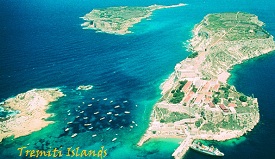 The Tremiti Islands can be reached by hovercraft from Manfredonia, Vieste and Termoli and in the summer by ferry from Rodi Garganico and Peschici. There is a helicopter service all year from Foggia.
The Tremiti Islands can be reached by hovercraft from Manfredonia, Vieste and Termoli and in the summer by ferry from Rodi Garganico and Peschici. There is a helicopter service all year from Foggia.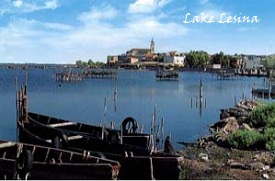 Some
Some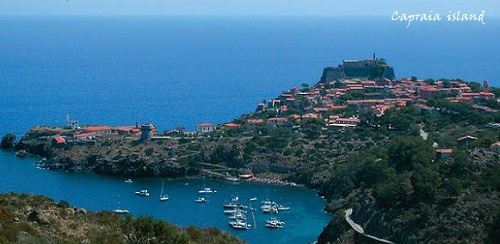

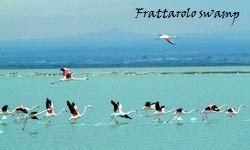 Indeed, there is an almost total lack of surface water sources, because all the waters run underground. In past times this territory, which is at present a National Park, contained eight natural reserves: Foresta Umbra, Sfilzi, Falascone, Isola Varano, Bosco di Ischitella e Carpino, Monte Barone, Lago di Lesina and Palude di Frattarolo.
Indeed, there is an almost total lack of surface water sources, because all the waters run underground. In past times this territory, which is at present a National Park, contained eight natural reserves: Foresta Umbra, Sfilzi, Falascone, Isola Varano, Bosco di Ischitella e Carpino, Monte Barone, Lago di Lesina and Palude di Frattarolo. 
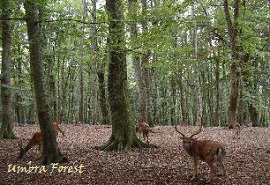 The most interesting aspect of the local vegetation is the Umbra Forest (from the Latin umbratilis, or shady): an extraordinary lowland Beech tree forest at only 700 meters with parts at 300 metres (the Beech tree normally is found at an altitude of 1000 to 1800 metres).
The most interesting aspect of the local vegetation is the Umbra Forest (from the Latin umbratilis, or shady): an extraordinary lowland Beech tree forest at only 700 meters with parts at 300 metres (the Beech tree normally is found at an altitude of 1000 to 1800 metres). 
 Rare diurnal and nocturnal predatory birds are also found such as the Peregrine falcon, the Red kite, the Goshawk, the Black kite and the Eagle owl, besides the important presence of the Raven. In the woods, we can easily see Jays, Cuckoos and Daurian jackdaws and the rare Sombre tit is also present. In the grass plains, the Little bustard and the Stone curlew, which are almost extinct, can be seen.
Rare diurnal and nocturnal predatory birds are also found such as the Peregrine falcon, the Red kite, the Goshawk, the Black kite and the Eagle owl, besides the important presence of the Raven. In the woods, we can easily see Jays, Cuckoos and Daurian jackdaws and the rare Sombre tit is also present. In the grass plains, the Little bustard and the Stone curlew, which are almost extinct, can be seen.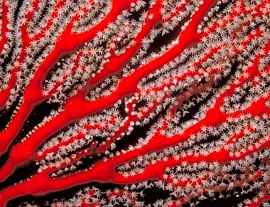 The environment of the Tremiti Islands also includes species of great natural value. The submarine environment of these islands is famous for the presence of numerous underwater caves, which hold interesting forms of life including a wide variety of sponges of various colours and sizes. In the deeper waters we find 'forests' of Red sea fan that offer one of the most unique Italian underwater itineraries.
The environment of the Tremiti Islands also includes species of great natural value. The submarine environment of these islands is famous for the presence of numerous underwater caves, which hold interesting forms of life including a wide variety of sponges of various colours and sizes. In the deeper waters we find 'forests' of Red sea fan that offer one of the most unique Italian underwater itineraries.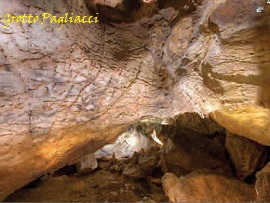 History and Culture: The complex system of Gargano's grottos and the natural presence of flint, used for the building of tools, favoured the presence of prehistoric settlements in the area of the National Park of Gargano, leaving us splendid cave paintings in the Pagliacci Grotto near Rignano Garganico, dating back some 15,000 years.
History and Culture: The complex system of Gargano's grottos and the natural presence of flint, used for the building of tools, favoured the presence of prehistoric settlements in the area of the National Park of Gargano, leaving us splendid cave paintings in the Pagliacci Grotto near Rignano Garganico, dating back some 15,000 years.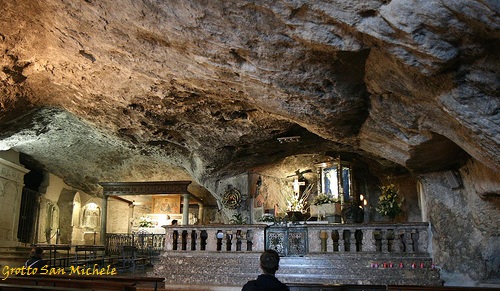
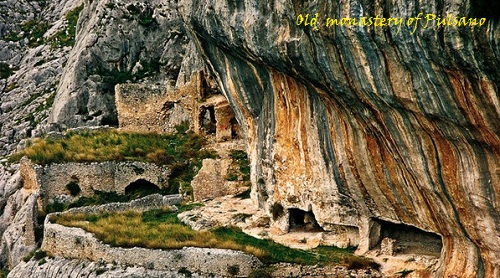
 Typical Products and Craftwork: Monte Sant'Angelo, Vico del Gargano and Peschici are famous craft centres. Here, we find objects of terracotta, wood and ceramics. Lathed shaped wooden objects are made such as at the string-spinning top and statues in olive wood. At Monte S. Angelo, ceramic for the pupi and the nativity scenes are made along with wrought iron and wooden objects.
Typical Products and Craftwork: Monte Sant'Angelo, Vico del Gargano and Peschici are famous craft centres. Here, we find objects of terracotta, wood and ceramics. Lathed shaped wooden objects are made such as at the string-spinning top and statues in olive wood. At Monte S. Angelo, ceramic for the pupi and the nativity scenes are made along with wrought iron and wooden objects.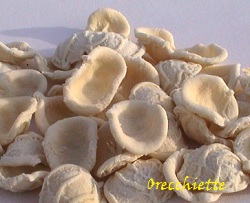 From the gastronomic point of view, here as in the rest of Puglia, we find the typical orecchiette as a first course and as a second course the specialities of Gargano, the magliatello (with baby goat meat) and capra acqua e sale (goat in salted water), in addition there are various combinations of seafood and local vegetables.
From the gastronomic point of view, here as in the rest of Puglia, we find the typical orecchiette as a first course and as a second course the specialities of Gargano, the magliatello (with baby goat meat) and capra acqua e sale (goat in salted water), in addition there are various combinations of seafood and local vegetables. 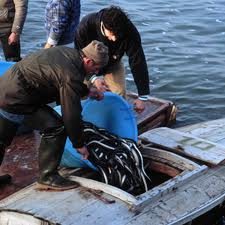 The eels of the Lake of Lesina are also very famous and, last but not least, the caciocavallo cheese of Gargano. Also noteworthy is the famous extra virgin olive oil which is produced locally in the numerous and often antique olive mills present in the extensive olive groves of the southern part of Gargano.
The eels of the Lake of Lesina are also very famous and, last but not least, the caciocavallo cheese of Gargano. Also noteworthy is the famous extra virgin olive oil which is produced locally in the numerous and often antique olive mills present in the extensive olive groves of the southern part of Gargano.